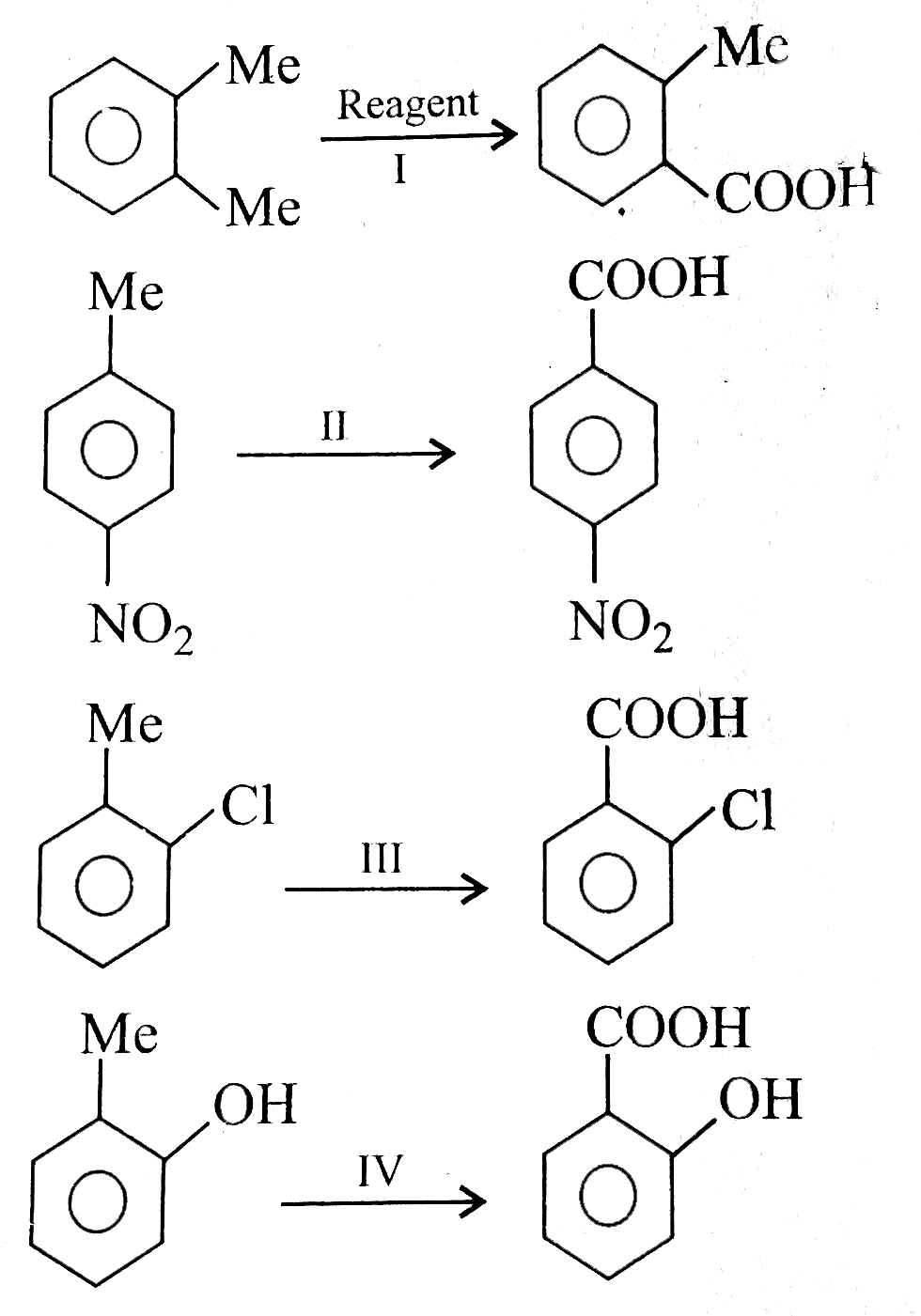Select the correct group(s) of reagent(s) used in the following conversions:

A
a.I⇒dil.HNO3, II⇒Na2Cr2O7/H2SO4
III⇒KMnO4/NaOH, IV⇒PbO4/ɵOH,H3O⊕
B
b.I⇒dil.HNO3,II⇒KMnO4/H⊕
III⇒KMnO4/NaOH,
IV⇒TsCl+accKMnO4+H2O
C
c.I⇒KMnO4/NaOH,II⇒Na2Cr2O7/H⊕,
III⇒KMnO4/ɵOH,IV⇒dil.HNO3
D
d.I⇒CrO3/MeCOOH,II⇒KMnO4/ɵOH,
III⇒KMnO4/H⊕,IV⇒dil.HNO3
Text Solution
The correct Answer is:A, B
(I) ⇒ Dilute HNO3 oxidies only one (Me−) group tp (−COOH) group.
(II) ⇒ EWG, e.g., (−NO2) group makes the benzene ring stable, so either acidic KMnO4 or acidic K2Cr2O7 can be used to oxidise the (Me−) group to (−COOH) group.
III ⇒(−I) effect of Cl makes the benxene ring stable, so oxidising agent such as alkaline KMnO4 or acidic K2Cr2O7 can be used to oxidise the (Me−) group to (COOH).
IV ⇒EDG(+R) effect of (−OH) group makes the benzene ring unstable, so either (−OH) has to be protected by tosylation using TsCl and then oxidation of (Me−) group to (−COOH) group by acidic KMnO4 is carried out followed by hydrolysis or by using a very mild O.A. such as PbO2/OH,H3O⊕. So the answers are (a) and (b).
|
Topper's Solved these Questions
- REDUCTION AND OXIDATION REACTION OF ORGANIC COMPOUNDSBOOK - CENGAGE CHEMISTRY ENGLISHCHAPTER - REDUCTION AND OXIDATION REACTION OF ORGANIC COMPOUNDSEXERCISE - Exercise (Single Correct)
90 Videos
- REDUCTION AND OXIDATION REACTION OF ORGANIC COMPOUNDSBOOK - CENGAGE CHEMISTRY ENGLISHCHAPTER - REDUCTION AND OXIDATION REACTION OF ORGANIC COMPOUNDSEXERCISE - Exercise (Assertion And Reasoning)
10 Videos
- REDUCTION AND OXIDATION REACTION OF ORGANIC COMPOUNDSBOOK - CENGAGE CHEMISTRY ENGLISHCHAPTER - REDUCTION AND OXIDATION REACTION OF ORGANIC COMPOUNDSEXERCISE - Exercise (Linked Comprehension)
52 Videos
- QUALITATIVE INORGANIC SALT ANALYSISBOOK - CENGAGE CHEMISTRY ENGLISHCHAPTER - QUALITATIVE INORGANIC SALT ANALYSISEXERCISE - Viva Voce Questions And Part-C (Analysis Of Cations)
42 Videos
- SOLID STATEBOOK - CENGAGE CHEMISTRY ENGLISHCHAPTER - SOLID STATEEXERCISE - Ex 1.2 (Objective)
9 Videos
Similar Questions
Knowledge Check
Give the correct sequence of reagents used for the following conversion.
 ADIBAL-H, NaBH4,H3O+/ΔBH3O+/Δ,NaBH4, DIBAL-HCNaBH4, DIBAL-1, H3O+/ΔDDIBAL-H, H3O+/Δ,NaBH4
ADIBAL-H, NaBH4,H3O+/ΔBH3O+/Δ,NaBH4, DIBAL-HCNaBH4, DIBAL-1, H3O+/ΔDDIBAL-H, H3O+/Δ,NaBH4The reagents (s) for the following conversion
 CH≡CH .Aalcoholic KOHBalcoholic KOH followed by NaNH2Caqueous KOH followed by NaNH2 .DZn/CH3OH
CH≡CH .Aalcoholic KOHBalcoholic KOH followed by NaNH2Caqueous KOH followed by NaNH2 .DZn/CH3OHThe reagent (s) for the followiing conversation
 Aalcoholic KOHBalcoholic KOH followed by NaNH2Caqueous KOH followed by NaNH2DZn/CH3OH
Aalcoholic KOHBalcoholic KOH followed by NaNH2Caqueous KOH followed by NaNH2DZn/CH3OH
The reagent(s) for the following conversion

is/are:
View SolutionThe reagent(s) for the following conversion

is/are:
View SolutionThe reagent(s) for the following conversion

is/are:
View SolutionThe reagent(s) for the following conversion,
 is/are:
is/are:
View SolutionThe reagent(s) for the following conversion is/are

View Solution

 is :
is :